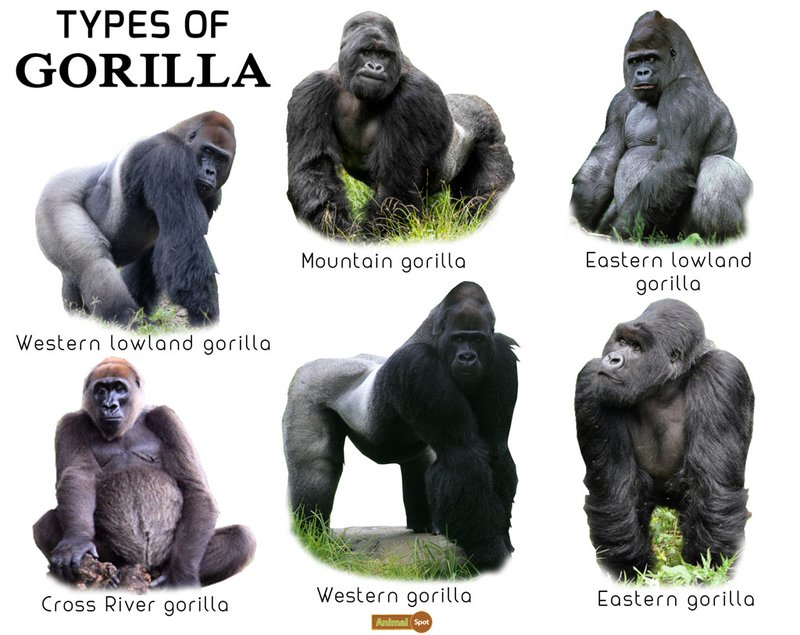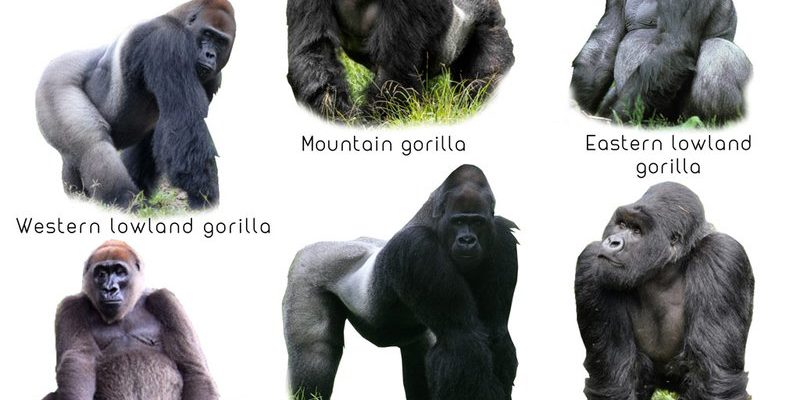
Exploring these animals is not just about appreciating their beauty; it’s also about understanding the rich diversity of life on Earth. So, let’s dive in! Here’s a rundown of **ten animals that resemble the Western Gorilla** and some easy ways to tell them apart. You might even find yourself using these comparisons in fun conversations with friends!
1. Eastern Gorilla
The **Eastern Gorilla** is the closest relative to the Western Gorilla, and they share a lot of similarities. Just imagine two siblings with a few small differences. Eastern Gorillas are generally larger and have a different coat color that appears darker, especially on their backs.
You might also notice that Eastern Gorillas have a slightly larger skull and a more pronounced brow ridge. Their habitats are mainly in the mountainous forests of the Democratic Republic of the Congo. While they both share a love for fruit and leaves, Eastern Gorillas tend to be more solitary than their Western counterparts, which often hang out in groups.
How to Tell Them Apart
– **Size:** Eastern Gorillas are typically larger.
– **Color:** Look for darker fur on the Eastern Gorilla.
– **Social Behavior:** Western Gorillas are often more social.
2. Chimpanzee
Chimpanzees are another species that may come to mind when thinking about animals similar to the Western Gorilla. They are both part of the great ape family, but chimps are smaller and have a more slender build. Picture a teenager who’s still growing; that’s kind of like a chimp compared to a full-grown gorilla.
Chimps are known for their intelligence and tool use, which sets them apart. They have long arms, and their faces are more expressive, often showing a range of emotions from joy to sadness. Their habitat includes a variety of forests and savannas in Africa, where they live in communities and forge strong social bonds.
How to Tell Them Apart
– **Build:** Chimpanzees are smaller and leaner.
– **Face:** Chimps have more expressive faces.
– **Behavior:** Gorillas are more solitary, while chimps love their communities.
3. Bonobo
Often confused with chimpanzees, **bonobos** look quite similar to them but are actually distinct species. Think of bonobos as the peacekeepers of the ape world, as they’re known for their social behaviors and less aggressive nature.
Their bodies are somewhat similar to chimpanzees, but bonobos have a darker face with pink lips and a more slender build. Bonobos are primarily found in the Congo Basin and live in matriarchal societies, where females often have the upper hand in social dynamics.
How to Tell Them Apart
– **Social Structure:** Bonobos have matriarchal societies.
– **Appearance:** Bonobos have darker faces.
– **Behavior:** Bonobos are more peaceful compared to chimpanzees.
4. Orangutan
When you compare **orangutans** to Western Gorillas, you’re looking at two quite different creatures, but they share some traits like long arms and a predominantly fruit-based diet. You might think of orangutans as the tree-dwelling cousins of gorillas, as they prefer to live in the canopies of tropical rainforests in Southeast Asia.
Orangutans have long, reddish-orange hair and are known for their intelligence, often using tools, too. Their solitary nature differs from the social structures seen in gorillas, making them unique among the ape family.
How to Tell Them Apart
– **Hair Color:** Orangutans have orangish fur.
– **Habitat:** Gorillas prefer the ground; orangutans live in trees.
– **Social Structure:** Gorillas are more social; orangutans are solitary.
5. Siamang
The **siamang** might not be as familiar as some of the other animals on this list, but they share some similarities with gorillas. These large gibbons are known for their impressive vocal abilities. If you’ve ever heard a loud, booming call in the jungle, there’s a good chance it was a siamang showing off its vocal chops!
Siamangs have long arms and are excellent climbers. They have a distinctive throat pouch that helps amplify their sound. While they share some physical traits with gorillas, their size and social behavior are quite different, as siamang live in family groups and are more agile.
How to Tell Them Apart
– **Size:** Siamangs are smaller than gorillas.
– **Vocalization:** Siamangs are known for their loud calls.
– **Behavior:** Siamangs prefer family groups, unlike gorillas.
6. Mandrill
Moving away from the apes but still in the primate family, the **mandrill** can be easily confused with a young gorilla due to its strong physique. Mandrills are brightly colored and are often noted for their striking blue and red facial markings. These monkeys are the largest of the baboon family and love living in groups.
Unlike gorillas, mandrills spend a lot of time on the ground and have a more varied diet, feasting on fruits, seeds, and even small animals. Their social structure is complex, with dominant males leading troops.
How to Tell Them Apart
– **Color:** Mandrills have vibrant faces and bodies.
– **Social Structure:** Mandrills live in larger groups.
– **Diet:** Different dietary preferences, with mandrills eating more variety.
7. Red Ape
**Red apes**, or the red-faced monkey, live in the same general regions as the Western Gorilla and can sometimes be seen in the same habitats. They’re known for their striking reddish-brown fur and are adapted well to life in the trees. In terms of size, red apes are smaller than gorillas but similar in body shape.
What sets them apart is their more playful behavior and social structure, as they tend to live in smaller family groups. Their diet is also more varied than that of gorillas.
How to Tell Them Apart
– **Size and Color:** Red apes are smaller and have redder fur.
– **Social Structure:** They live in smaller groups.
– **Diet:** More varied dietary habits than gorillas.
8. Common Langur
The **common langur** is another primate that may remind you of gorillas at first glance. With a leaner build and a long tail, langurs inhabit forests across South Asia. They’re known for their impressive leaps from tree to tree, making them agile in their environment.
Langurs are social animals and usually live in groups led by a dominant male. Their diet primarily consists of leaves, fruits, and flowers, but they tend to be smaller and less robust than gorillas.
How to Tell Them Apart
– **Build:** Langurs are smaller and leaner.
– **Tail:** Langurs have long tails.
– **Habitat:** Found in different regions than gorillas.
9. African Grey Parrot
While not a primate, the **African Grey Parrot** shares its habitat with Western Gorillas in the rainforests of Africa. Known as one of the most intelligent bird species, African Greys have a striking resemblance to young gorillas in their curiosity and playful nature.
Though they don’t look much alike, their social nature and reliance on communication make them similar in spirit. Both animals are known for their intelligence, but, of course, they belong to vastly different categories in the animal kingdom.
How to Tell Them Apart
– **Species:** One is a bird; the other is a primate.
– **Appearance:** Gorillas are large and furry; African Greys are small and feathered.
– **Behavior:** Both are intelligent and social, but in different ways.
10. Baboons
Finally, we have the **baboon**. Similar in size and strength, baboons are often seen as more temperamental and aggressive compared to the relatively calm demeanor of gorillas. They have a distinctive face with a long muzzle and large canines, giving them a different look.
Baboons are social animals that thrive in groups, often exhibiting complex social structures. They inhabit savannas and woodlands, where they forage for fruits, seeds, and other food. While they share some physical similarities with gorillas, their behavior and social interactions are notably different.
How to Tell Them Apart
– **Facial Features:** Baboons have long muzzles and larger teeth.
– **Social Behavior:** Gorillas are more peaceful, while baboons can be aggressive.
– **Habitat:** Different environments; gorillas are in dense forests.
As you explore the animal kingdom, it’s fascinating to see how diverse yet similar these creatures can be. Each species has its unique traits, behaviors, and habitats, making them special in their own right. The next time you think about the **Western Gorilla**, remember all the incredible animals that share its world, and appreciate the beauty of their differences!

